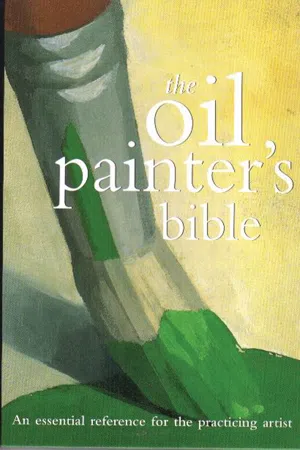
eBook - ePub
Oil Painter's Bible
An Essential Reference for the Practicing Artist
Marylin Scott
This is a test
Compartir libro
- 192 páginas
- English
- ePUB (apto para móviles)
- Disponible en iOS y Android
eBook - ePub
Oil Painter's Bible
An Essential Reference for the Practicing Artist
Marylin Scott
Detalles del libro
Vista previa del libro
Índice
Citas
Información del libro
Learn how to use and enjoy one of the most satisfying painting mediums with this handy compact guide. Contains essential information on the materials, equipment, and techniques for creating accomplished works in oils. Step-by-step sequences show how to paint a range of themes, from still life to portraits and landscapes, with advice on more difficult subjects. Includes suggestions for presenting your finished paintings and how to go about getting your work seen and exhibited.
Preguntas frecuentes
¿Cómo cancelo mi suscripción?
¿Cómo descargo los libros?
Por el momento, todos nuestros libros ePub adaptables a dispositivos móviles se pueden descargar a través de la aplicación. La mayor parte de nuestros PDF también se puede descargar y ya estamos trabajando para que el resto también sea descargable. Obtén más información aquí.
¿En qué se diferencian los planes de precios?
Ambos planes te permiten acceder por completo a la biblioteca y a todas las funciones de Perlego. Las únicas diferencias son el precio y el período de suscripción: con el plan anual ahorrarás en torno a un 30 % en comparación con 12 meses de un plan mensual.
¿Qué es Perlego?
Somos un servicio de suscripción de libros de texto en línea que te permite acceder a toda una biblioteca en línea por menos de lo que cuesta un libro al mes. Con más de un millón de libros sobre más de 1000 categorías, ¡tenemos todo lo que necesitas! Obtén más información aquí.
¿Perlego ofrece la función de texto a voz?
Busca el símbolo de lectura en voz alta en tu próximo libro para ver si puedes escucharlo. La herramienta de lectura en voz alta lee el texto en voz alta por ti, resaltando el texto a medida que se lee. Puedes pausarla, acelerarla y ralentizarla. Obtén más información aquí.
¿Es Oil Painter's Bible un PDF/ePUB en línea?
Sí, puedes acceder a Oil Painter's Bible de Marylin Scott en formato PDF o ePUB, así como a otros libros populares de Art y Art Techniques. Tenemos más de un millón de libros disponibles en nuestro catálogo para que explores.
Información
Categoría
ArtCategoría
Art Techniques
Fat over lean
Paint which has a high percentage of oil is described as “fat.” “Lean” paint is that which has been thinned with turpentine or mineral spirit only. The golden rule in oil painting is to paint fat over lean, and there are good reasons for this. The drying oils used both in the manufacture of paint and as a medium do not evaporate. They simply dry and harden on exposure to air, but this takes a long time (six months to a year to become completely dry). During this process the paint surface shrinks a little. If lean paint has been applied over oily paint the top layer will dry before the lower one has finished shrinking, and this can cause the hardened lean paint to crack and even flake off.
So, for any painting built up in layers the oil content should progressively increase. The usual practice is to begin with turpentine alone, or turpentine with just a little oil added, and add more oil to the mixture as the painting progresses. The final layer can be as thick as you like, and this is when artists sometimes add highlights in impasto (see page 88).

The blue paint on the left is lean, as it has been well diluted with turpentine. The red paint, straight from the tube, has a much more substantial texture.

1 Some preliminary underpainting in thin, lean paint provides a basis for the application of subsequent layers of oilier paint.

2 The image is built up using slightly thicker paint, but this is less oily than that which will be used later.
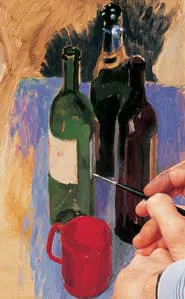
3 Apart from the danger of paint cracking as it dries, another reason for painting fat over lean is that it is difficult to add lean paint to a very oily layer. It does not adhere properly, so your brush tends to lift if off again.
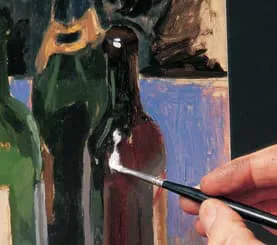
4 Fat white paint straight from the tube is applied for the highlights. This must be done last, as it would be impossible to paint further over these oil-rich patches with the paint still wet.
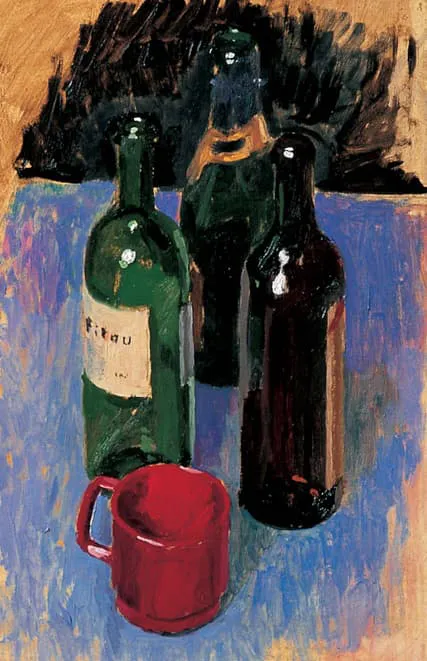
5 The completed painting shows a mixture of different paint thicknesses. The blue tabletop consists of quite lean paint while parts of the bottles have been built up with increasingly oily paint.
Alla prima
This is an Italian term meaning “at first,” and it describes paintings completed in one session. The essential characteristic of this method is that there is no initial underpainting as such (see page 112), although artists will often make a rapid underdrawing in pencil or charcoal to establish the main lines.
After the introduction of tubed paint in the mid-19th century, artists were able to work outdoors more easily. This plein air (open air) painting, as it is called, first undertaken by painters such as Constable, Corot and later the Impressionists, established the rapid and direct approach as an acceptable technique. Hitherto, oil painting had been largely a studio activity, as pigment had to be ground by hand, and paintings were built up slowly in a series of layers.
Working alla prima requires some confidence, as each patch of color is laid down more or less as it will appear in the finished picture. Any modifications and reworking must be kept to a minimum so that the fresh effect is not destroyed.

1 Because it is difficult to get ellipses right, these were first drawn with pencil. The next stage was to block in some of the shaded areas with cobalt blue and the tablecloth with ocher, which helped to establish the feel of the composition. This photograph shows some of the basic colors being laid in with somewhat thicker paint. The colors are those that will appear in the finished painting, though minor modifications can be made as the work progresses.
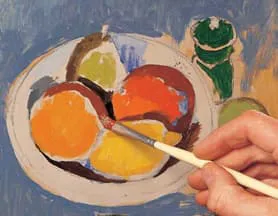
2 The tablecloth has been loosely painted, and now the darker tones of the fruit are developed. The bold brushstrokes give a three-dimensional appearance.
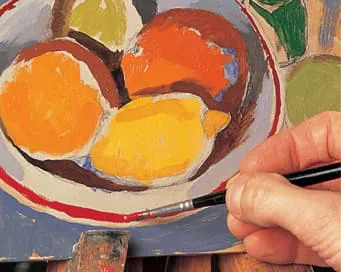
3 The red stripe around the bowl is crucial to the composition, so it is painted next, in a mixture of cad...